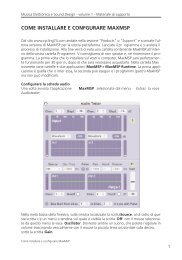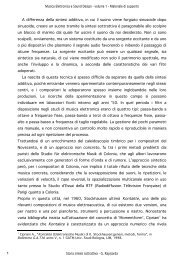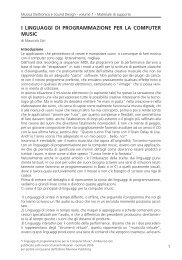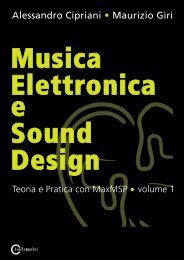programming with max/msp - Virtual Sound
programming with max/msp - Virtual Sound
programming with max/msp - Virtual Sound
You also want an ePaper? Increase the reach of your titles
YUMPU automatically turns print PDFs into web optimized ePapers that Google loves.
3.1<br />
358<br />
Practice<br />
Make sure to try several frequencies for all of the waveforms, while watching<br />
the image being produced by the spectroscope.<br />
As stated, the spectrum of the sound being input is what is being displayed: the<br />
components of the sound are distributed from left to right across a frequency band<br />
that ranges from 0 to 22,050 Hz by default. These two values, the minimum and<br />
<strong>max</strong>imum frequencies that the spectroscope can display, can be modified in the<br />
Inspector, using the “Lo and Hi Domain Display Value” attribute in the Value tab.<br />
Try adding a spectroscope~ object to a patch that you have already created,<br />
so to familiarize yourself <strong>with</strong> the relationship between sound and its spectral<br />
content. You might add the object to the patches found in previous chapters. In<br />
01_14_audiofile.<strong>max</strong>pat, for example, you might try connecting the spectroscope<br />
to the left outlet of the sfplay~ object, or in IA_06_random_walk.<strong>max</strong>pat,<br />
you might try connecting it to the outlet of [p monosynth]. (In this last patch,<br />
are you able to see the relationship between the frequency of the sound and<br />
the shape of the spectrum? Try preset number 5.)<br />
Let’s move on to a discussion about ways to produce various types of noise<br />
in Max/MSP. The first, white noise, is generated using the noise~ object (as<br />
shown in Figure 3.3).<br />
Fig. 3.3 The white noise generator<br />
In the figure (which we encourage you to recreate on your own) we have connected<br />
the noise generator to a spectroscope~ object, through which we<br />
can see that the spectrum of white noise contains energy at all frequencies.<br />
Unlike the sound generators that we have already encountered, the white noise<br />
generator doesn’t need any parameters; its function is to generate a signal at<br />
the sampling rate consisting of a stream of random values between -1 and 1 (as<br />
we discussed in Section 3.1T).<br />
The second type of noise generator that is available in Max/MSP is the pink~<br />
object, which, unsurprisingly, generates pink noise (as seen in Figure 3.4).<br />
Fig. 3.4 Pink noise<br />
Paragraph 3.1 - <strong>Sound</strong> sources for subtractive synthesis<br />
from “Electronic Music and <strong>Sound</strong> Design” Vol. 1 by Alessandro Cipriani and Maurizio Giri<br />
© ConTempoNet 2010 - All rights reserved







